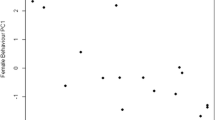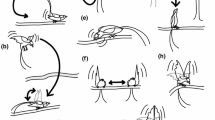Abstract
Female common chameleonChamaeleo chamaeleon shows shifts in body colorations during the mating season associated with their sexual stage. The hypothesis that female colorations are used in the inter-sexual communication was tested in the field by using plastic models painted with female-like colors. Three female colorations (Neutral, Receptive and Gravid) and two artificial colorations (White and White plus black spots) as control were used. Twenty models (5 colorations × 4 replicas) were simultaneously located in the field (n=25 experiments), and the reaction by males was scored from 0 (no reaction) to 4 (copulation attempt). A male was observed nearby a model in 59 out of 500 displays. A total of 23 males (38.9%) actively reacted to the model. The response significantly differed among color types, and receptive-like models obtained the strongest response by males. In five cases, males attempted to copulate with the model. The response to receptive coloration by males agrees with previous field studies and suggests that yellow spots with a green background is a courtship releaser.
Similar content being viewed by others
References
Andersson, M. 1994 Sexual Selection. Monographs in Behaviour and Ecology. Princeton University Press, Princeton, New Jersey.
Blasco, M., J. Cano, E. Crespillo, J. C. Escudero, J. Romero, & J. M. Sánchez. 1985 El Camaleón Común (Chamaeleo chamaeleon) en la Península Ibérica. Monografía 43, ICONA. Ministerio Agricultura Pesca Y Alimentación. Madrid.
Chauvin, R. 1969 Psychophysiologie II. Le comportement animal. Masson et Cie. Eds. Paris. 418 pp.
Cooper, W.E., Jr. 1984 Female secondary sexual coloration and sex-recognition in the keeled earless lizard,Holbrookia propinqua.Anim. Behav. 32: 1142–1150.
Cooper, W.E., Jr. 1988 Aggressive behavior and courtship rejection in brightly and plainly colored female keeled earless lizard (Holbrookia propinqua).Ethology 77: 265–278.
Cooper, W.E. & N. Greenberg 1992 Reptilian coloration and behavior. In: C. Gans & D. Crews (eds.).Biology of Reptiles. Hormones, Brain and Behavior Vol. 18, pp. 298–422, Univ. of Chicago Press, Chicago.
Cuadrado, M. 1998 The use of yellow spot colors as a sexual receptivity signal in females ofChamaeleo chamaeleon.Herpetologica 54, 395–402.
Cuadrado, M. & M. Rodríguez 1997 Distribución actual del camaleón en la península Ibérica.Quercus 133: 31–36.
Cuadrado, M. & J. Loman 1999 The effects of age and size on reproductive timing in femaleChamaeleo chamaeleon.J. Herpetol. 33: 6–11.
Dawkins, R. & J.R. Krebs 1978 Animal signals: information or manipulation? In: J.R. Krebs & N.B. Davies (eds).Behavioural Ecology: An Evolutionary Approach, Blackwell Scientific Publications. Oxford. pp. 282–309.
Götmark, F. 1995 Black-and-white plumage in male pied flycatchers (Ficedula hypoleuca) reduces the risk of predation from sparrowhaks (Accipiter nisus) during the breeding season.Behav. Ecol. 6: 22–26.
Kohda, M. 1981 Interspecific territoriality and agonistic behavior of temperate pomacentrid fish,Eupomacentrus altus (Pisces: Pomacentridae).Z. Tierpsychol. 56: 205–216.
Lack, D. 1943 The life of Robin. H.F. & G. Witherby. 4th. Edition, London. pp. 240.
Madsen, T. & J. Loman 1987 On the role of color display in the social and spatial organization of male rainbow lizards (Agama agama).Amphibia-Reptilia 8: 365–372.
Marler P. & W.J. Hamilton III 1966 Mechanisms of Animal Behavior. John Willey & Sons, Inc. New York.
Olsson, M. 1994 Why are sand lizard males (Lacerta agilis) not equally green?Behav. Ecol. Sociobiol. 35: 169–173.
Ono, T. 1981 Factors releasing the copulation attempt in three species of Phycitidae (Lepidoptera: Phycitidae).Appl. Entomol. Zool. 16: 24–28.
Parcher, S.R. 1974 Observations on the natural histories of six Malagasy Chamaeleontidae.Z. Tierpsychol. 34: 500–523.
Peek, R. 1997 De Jemenkamelon (Chamaeleo calyptratus).Lacerta 55: 254–261.
Robinson, M.D. 1978 Sexual dichromatism in the Namaqua chameleon (Chamaeleo namaquensis).Modoqua 2: 81–83.
Tinbergen, N. 1948 Social releasers and the experimental methods required for their study.Wilson Bull. 60: 6–51.
Tinbergen, N. 1951 The Study of Instinct. Oxford University Press. London.
Valverde, J.A. 1982 Librea básica y coloración social en el Camaleón común,Chamaeleo chamaeleon (L.).Publ. Centr. Pir. Biol. Exp. 13: 55–70.
Watkins G.G. 1997 Inter-sexual signalling and the functions of female coloration in the tropidurid lizardMicrolophus occipitalis.Anim. Behav. 53: 843–852.
Author information
Authors and Affiliations
Corresponding author
About this article
Cite this article
Cuadrado, M. Models painted with female-like colors elicited courtship by male common chameleons: Evidence for a courtship releaser. J Ethol 16, 73–79 (1998). https://doi.org/10.1007/BF02769285
Received:
Accepted:
Issue Date:
DOI: https://doi.org/10.1007/BF02769285




